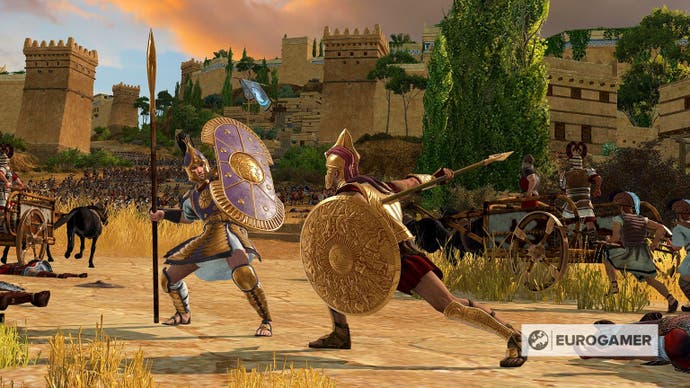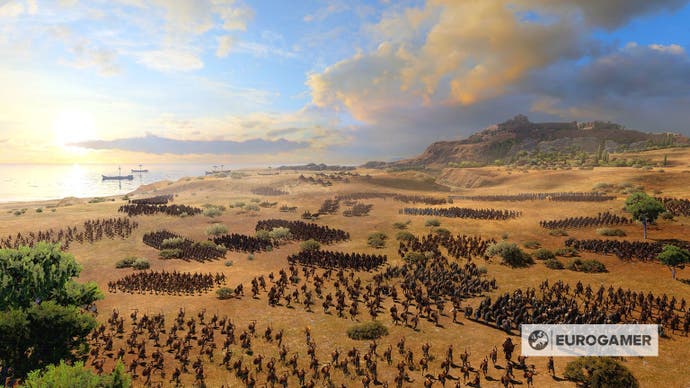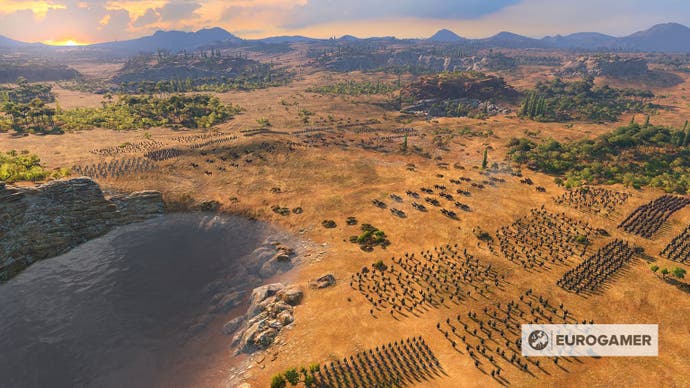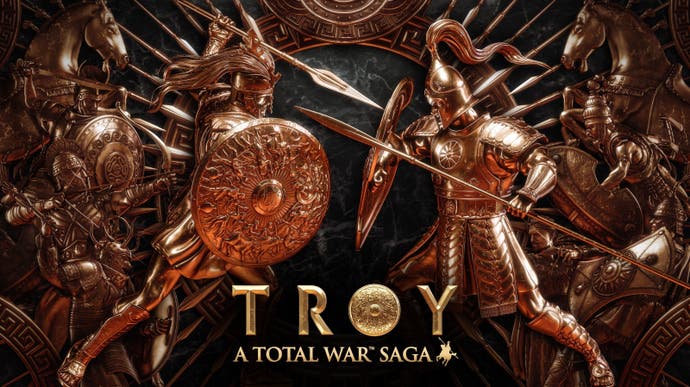Total War Saga: Troy's battles feel a tad dry, but its mythology is fascinating
Bloomin' Hector.
The Bronze Age, it turns out, is not an easy period to turn into a historically accurate, highly detailed video game like Total War. But it does sound fascinating. There are huge gaps in important places, unusual changes to how armies are proportioned, and the small matter of Homer's Iliad sprinkling myth and magic over everything.
Playing it, I think there's room for a little more of the mythical stuff - but talking to Total War Saga: Troy's game director Maya Georgieva and senior game designer Milcho Vasilev, I'm also confident there's a good deal more to come.
"We wanted to take a direction that has not been taken by any Total War before," Georgieva told me, "this period of history, which is ancient history, the Bronze Age... I mean no Total War has gone there before us, and there's a good reason for that! It's not been missed by accident, it's really tough for a Total War game to go into this era because the sources that we need to make an on-par experience with the titles that you love are missing, or are scarce in that period.
"So for example, we don't have a lot of historical records. We have a lot of archaeological evidence, but we don't have, for example, the names of rulers of countries - the specifics that breathe soul into the historical narrative." This is where the Iliad comes in: providing detail and inspiration for nation-states, rulers, "the leaders or the heroes or the personas and characters of the military," as Georgieva puts it. "This basically makes the whole project possible".
"The way we are presenting them is basically threading this very narrow path between reality and the narrative. Because, well, what we found out is that the narrative of the Iliad is very powerful. It has its own gravity, it draws us always towards it. So, from the beginning, we decided that one of the key points of the project will be: we are going to make a sandbox Total War game, but the events of the Iliad will be a plausible playthrough in that sandbox." (Worth noting here is that there's definitely no two-campaign option like the Romance and Records versions of Total War: Three Kingdoms, although it's not something Georgieva ruled out for something post-launch. "That would have been a very nice option, but the scope of the Saga really doesn't allow us to do that. I mean, we don't have the luxury of making two games in one. But still, there are possibilities, probably after release. We'll see.")

As for how those gaps are filled by the more fantastical parts of sources like the Iliad, Creative Assembly has opted for a "truth behind the myth" approach, effectively looking to make as factually accurate a Total War as possible and using the most probable explanations for the myths and legends to complete the history - a fascinating approach, philosophically, but one that can make you feel slightly underwhelmed when, say, the Minotour turns out to just be a big, tanky bandit dude in silly armour.
"We knew that we were going to have a difficulty with the unit variety in the game because of the Bronze Age and the way that warfare was conducted at the time," Vasilev explained, and this is where mythological units, or mythologically inspired units, come in. The Cyclops, for instance, is a giant that sounds like more or less a properly mythical being in the game, and works to supplement the units of the era. "The Cyclops can be really good at sieges, because he is a unit that is able to destroy even huge gates, he's able to throw a boulder over the siege walls to damage units behind it, and so on." Others like the Centaurs, meanwhile, are more easily explained by the available facts, and so in-game they're effectively just cavalry. As Vasilev put it, "we believe that the myth that has inspired the half-human half-horse centaurs is rooted in that period where people were not using horses much, but they would see some other tribe, not being very adept at that horse riding [themselves], or even fighting for horseback, and they would probably say that they are 'one with their horse'." They won't be readily available though. To get these kinds of units players need to go "a bit out of their way" to recruit them on the campaign map first, and they sound either very limited or completely unique in their supply.

When it comes to the battles themselves, this truth-seeking approach can make things feel a little flat. I played a single, fairly standard land battle in control of the Greeks, and their hero Achilles, against the Trojan army and hero Hector, with a decent amount of units on either side, including Centaurs for me and the "Minotaur" for Hector. In other words, I have lots of infantry and archers and one cavalry unit (plus a unit of slow chariots), and the enemy has an entire infantry force with one big man.
That slightly underwhelming impression aside, the immediate thing you'll notice as a returning Total War player is that lack of cavalry. Total War's real-time battles are, more often than not, about using speed, positioning, and flanking, and taking almost all cavalry out of the game completely disrupts the balance of that, and so Creative Assembly has had to quite noticeably shuffle some other things around. A big change is light infantry are faster, heavy infantry are slower, and there are more infantry types that have special bonuses like increased flanking strength, increased resistance to flanking, or outright immunity to it.
There's also a big change to the landscape of the battle maps themselves: light cover, in the form of long grass, has been introduced, as have sand and mud. Light infantry can move into long grass to be hidden, like units traditionally would be in forests. Heavy infantry are severely slowed in mud, while light infantry are unaffected and medium only slightly slowed - similarly with sand. Basically, flanking-specialised light infantry units become your traditional light cavalry, and micro-managing unit positioning around different types of battlefield terrain becomes more important than ever.

In practice, it can be a little finickity. If you're a frequent pauser, expect to pause even more frequently. If you're not, expect even more emphasis on your actions-per-minute and attention to detail (which is especially important, given the dusty biome of this battle meant it was often a little hard to tell between long grass and just slightly-longer-than-usual grass that doesn't have the same effect). There's also not a huge amount of visual distinction between units, especially the more elite ones, like Achilles' Myrmidons say, that in other Total Wars you'd expect to be more instantly identifiable in the fray.
That said, it's still interesting to have to rethink your tried-and-tested strategies - in fact, Warhammer games aside, this is probably the most impactful change to Total War's battles I can remember. It's something plenty of history nerds will find stimulating, as much as others might find it slightly dry. That's the nature of the Bronze Age, really, but thankfully for the less fustily-inclined like me we have the other half of the narrative to do some making up. The big thing that's got me excited is the siege of Troy.
"The siege of Troy needs to be a spectacular event, or at least a special event in a Bronze Age game. Because of the power of the narrative," Georgieva said. That means - rejoice! - there is a Trojan Horse in the game, despite some suggestions that it would just be implemented as an earthquake for the sake of historical accuracy. "I think that's a little bit of a misconception," Georgieva explained. "There are actually three horses, three Trojan horses in Total War Saga: Troy... the way we've implemented the horse is we took the three most plausible, most possible options and implemented them.

"The far fetched one is the allegory of the earthquake. Earthquakes are quite common in the area even today, and we have archeological evidence that Troy's walls were destroyed by an earthquake at the appropriate period of history in that time. So that was one of the interpretations, which is modelled into the game as a window of opportunity where you can attack Troy well after an earthquake because the walls are down, the garrison is weakened and you can just approach the city in a much more favourable way.
"The other ways to approach Troy with a Trojan horse are with a siege tower that is shaped like a horse. We know that a couple of centuries later the Assyrians fielded such siege machinery, which is sometimes referred to by the animal names. So we see that probably in the Trojan War, this is like a prototype, a 'beast of war', we call it in the game. It's unlockable through a technology. And the other, the third one, is probably the closest to the narrative, because it involves the same tactic: a wooden structure filled with treasure, and also hidden units.
"This though, again has a historical tint to it because we realised that in that period of time Phoenician ships were horse-headed vessels, and also all ships would have been used for devoting things to the divine, to the gods. So we are basically replaying this sort of scenario where a ship with a horse's head is filled with goods, and also hidden soldiers. And when you get to do that strategy, you play on a specific map that doesn't exist outside of the strategic map. It's during the night, the gates of Troy are open, and you start with several units inside the city. So it's a completely new scenario. And those three ways exist in the game and give you the opportunity to choose your own Trojan horse."
Vasilev also explained that there are at least three separate versions of the battle map for the siege of Troy itself, including the standard 360-view one you'll know from usual Total War sieges. "It's not just an earthquake that we've implemented as a Trojan horse." Finally, although Creative Assembly was at pains to make clear there'd be little talk of the campaign just yet, there's an intriguing tease of a proper rework for agents, the units like spies and heroes that roam around providing support and intel on the campaign map.
Here's what Georgieva told me about those: "after Thrones of Britannia, the previous saga, we were looking a lot at the feedback that we received and several systems that didn't make the cut for Thrones. So for example, agents... they have a good and a bad side, let's say. So we were trying everything to alleviate, for example, agent spamming on the map, but [in doing so] we were also having a lot of new interesting takes on the agent archetypes. We're also implementing Epic Agents, which are mythologically inspired. And they are quite unique. I mean, we haven't had anything like this in a previous title before."
That little tease, plus the promise of a little more invention and bombast with the big siege of Troy, the suggestion that the campaign will offer some interesting scripted moments that line up with Homer's epic, and the opportunity to relearn some habits in the battles themselves is enough to keep me excited. Translating this era into something like Total War sounds extremely challenging - the slight flatness of that battle I tried a few times being evidence of the fact - but the novelty of it, the magic of the period, and just the magnetic quirkiness of the actual required historical process itself, is still undeniable.





